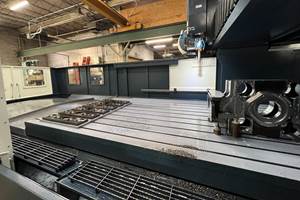The Case For Constant Velocity
Constant Velocity Technology uses high speed computer hardware and creative algorithms to enable machine tools to achieve fast, consistent feed rates across complicated 3D surfaces.
Share






A machine tool’s control can be a barrier to reducing the machining cycle time and improving the finish of complicated 3D molds, aerospace parts or medical-device components. When the processor can’t keep up with the program, the drives starve for information, slowing tool progress, increasing cycle time and inducing inconsistent tool motion. This causes inefficient use of the spindle, which increases benchwork finishing time in addition to the number of trips to the tool crib to replace worn, overloaded tooling. GBI Cincinnati and MTI Technologies worked together on this problem and came up with a series of machine tools called Revolution. These machines are said to combine the quickness of modern control technology and precision in machine tool motion to yield true constant velocity.
Savvy manufacturing engineers and CNC programmers know that programming at a feed rate of 100 ipm does not guarantee that the tool moves at 100 ipm. In fact, it is almost always less than the target feed rate. The reason for this is that the control’s ability to generate the position of the tool in space given the part geometry, tool height offsets, tool radius offsets, common offsets and workpiece offsets requires complicated algorithms that must generate every point in the tool path as the tool moves across the part. The control also must calculate approach and escape motions as well as acceleration and deceleration.
Most controls in use today trace their roots to architecture that is 30 or even 40 years old, when among other things the download speed of the RS-232 connection was a bottleneck. Controls of this type can yield block-read speeds of up to 5,000 blocks per second. While this is sufficient for many part programs, complicated parts can require much more than that. When MTI‚Äôs Carlo Miceli began to work on his own control, he started with a fresh approach to PC machine language logic and efficient information processing. The product was a CNC control based on modern PC hardware coupled with a new approach to toolpath algorithms that produces a read speed of more than 50,000 blocks per second. GBI Cincinnati says the result is ‚Äúconstant velocity‚ÄĚ machining, which yields fast, constant feed rates. When the velocity (feed rate) is not constant, several problems can result.
The uneven motion of the tool loads the flutes differently as the tool passes through the part, adversely affecting accuracy and surface finish. Inconsistent motion can also shorten tool life by not moving the cutter fast enough to maintain minimum chip load, causing it to rub rather than cut. Such motion can also create small breaks in the tool’s edges, creating heat and dulling the tool. However, by using constant velocity, the average speed of the cutter moving across the part is more uniform and more accurate, reducing finishing time and prolonging tool life.
On the Revolution series of machining centers, the MTI control does not create the excessive stress sometimes associated with high speed machining, allowing fluid tool motion for complicated part geometries.
The MTI control can also be retrofitted to an existing machine. The retrofit kit uses a series of control parameters to determine the maximum allowable G-force loading and safe operating limits. Standard kits are available now for many Fadal machining centers, with kits for other machines to become available in the future.
One result of the high block processing speed is that the control-follow error is constantly monitored and adjusted to achieve uniform tool motion and surface integrity during program execution. The system uses more than 80 high speed buffers to control and monitor tool motion, which can be adjusted instantaneously if the follow error becomes excessive.
The sum of the control quickness, drive tuning and efficient handling of the tool path is said to yield fast and accurate program execution even when working with complicated shapes. GBI Cincinnati plans to have three Revolution machining systems ready by IMTS 2008. Each will offer machine design features with MTI’s control technology to solve problems in the moldmaking, aerospace and medical device industries.
Related Content
In Moldmaking, Mantle Process Addresses Lead Time and Talent Pool
A new process delivered through what looks like a standard machining center promises to streamline machining of injection mold cores and cavities and even answer the declining availability of toolmakers.
Read MoreDN Solutions America Unveils Impressive Chicago Technical Center at IMTS 2024
New tech center is serving as a cutting-edge showroom and a technological hub for advanced machining applications.
Read MoreTsugami Lathe, Vertical Machining Center Boost Machining Efficiency
IMTS 2024: Tsugami America showcases a multifunction sliding headstock lathe with a B-axis tool spindle, as well as a universal vertical machining center for rapid facing, drilling and tapping.
Read MoreThree-Axis Bridge Mill Opens New Doors for Construction OEM
Different industries often require different machining priorities, a truism recently demonstrated by Barbco, an OEM of heavy-duty boring equipment that opened up new design possibilities by pivoting toward rigid, less complex machining centers.
Read MoreRead Next
AMRs Are Moving Into Manufacturing: 4 Considerations for Implementation
AMRs can provide a flexible, easy-to-use automation platform so long as manufacturers choose a suitable task and prepare their facilities.
Read MoreMachine Shop MBA
Making Chips and łŖŇ‚¬ ŃýļŌ≤ are teaming up for a new podcast series called Machine Shop MBA—designed to help manufacturers measure their success against the industry’s best. Through the lens of the Top Shops benchmarking program, the series explores the KPIs that set high-performing shops apart, from machine utilization and first-pass yield to employee engagement and revenue per employee.
Read More



















